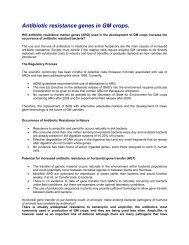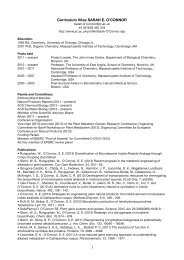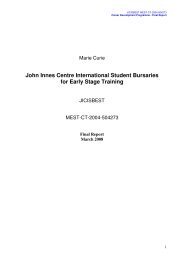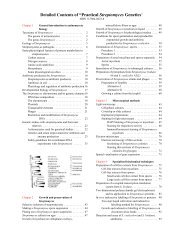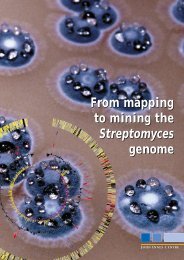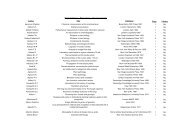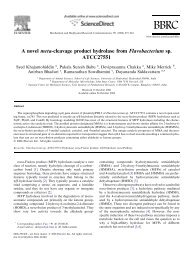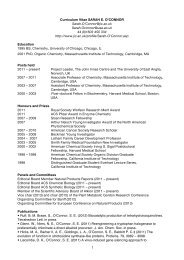1910s Timeline - John Innes Centre
1910s Timeline - John Innes Centre
1910s Timeline - John Innes Centre
You also want an ePaper? Increase the reach of your titles
YUMPU automatically turns print PDFs into web optimized ePapers that Google loves.
1926 William Bateson dies<br />
suddenly<br />
William Bateson dies after a<br />
brief and unexpected illness on<br />
8 February 1926 at the age of<br />
64. His last paper, ‘Segregation’<br />
is published in the Journal of<br />
Genetics. Here he lists his<br />
continuing difficulties with<br />
chromosome theory, argues<br />
that it leaves too many of the<br />
problems of heredity and<br />
variation in plants unexplained,<br />
and concludes that the<br />
acceptance of chromosome<br />
theory as a general theory of<br />
heredity should be postponed.<br />
Readers of the Journal, have<br />
come to identify Bateson’s<br />
‘Merton years’ with his series of<br />
investigations on variegation,<br />
bud-sports, root cuttings, and<br />
‘rogues’ in peas.<br />
C D Darlington later wrote: ‘The<br />
disappearance of his powerful<br />
personality left English genetics<br />
looking very empty indeed… the<br />
development of genetics was<br />
widely resented as a threat to<br />
estab[lished] teaching of botany<br />
& zoology in the English<br />
universities. The conflict was<br />
keenest in the University of<br />
London & on the governing<br />
body of <strong>John</strong> <strong>Innes</strong> itself’.<br />
Consequently the <strong>John</strong> <strong>Innes</strong><br />
Horticultural Institution faced an<br />
uncertain future, it was far from<br />
clear who Bateson’s scientific<br />
successor would be, or in what<br />
direction the Institution would<br />
be taken.<br />
See:<br />
http://jhered.oxfordjournals.or<br />
g/<br />
cgi/reprint/17/12/433<br />
1927 JIHI appoints a new<br />
director and head of genetics<br />
Sir Alfred Daniel Hall, who is<br />
well known as a former Director<br />
of Rothamsted, is appointed<br />
Director.<br />
Inexperienced in genetics<br />
himself, he appoints J B S<br />
Haldane to the staff as parttime<br />
head of genetical research.<br />
Hall’s actions and the arrival of<br />
Haldane come as a relief to the<br />
researchers at JIHI. C D<br />
Darlington notes that Hall<br />
might well have dismantled the<br />
genetics research, or might have<br />
followed the promptings of the<br />
cytologist R Ruggles Gates, or<br />
of E W MacBride or J B Farmer<br />
on JIHI’s Governing Council.<br />
By ‘miraculous good fortune’<br />
Hall did none of these things but<br />
took Julian Huxley’s advice and<br />
recruited Haldane. Haldane<br />
went on to develop the<br />
application of mathematical<br />
theory to genetics.<br />
Under Hall and Haldane<br />
biochemical research is<br />
introduced at JIHI. A fruit store<br />
is equipped as a chemical<br />
laboratory with special rooms<br />
‘for polariscope and<br />
combustions’ and Haldane<br />
announces his intention to start<br />
‘a systematic biochemical study<br />
of flower colour variation in the<br />
extensive genetical material<br />
available’ at JIHI.<br />
1927 Dorothy Cayley discovers<br />
the cause of ‘breaking’ in tulips<br />
Dorothy Cayley, JIHI’s<br />
mycologist, shows that<br />
‘breaking’ in tulips is caused by a<br />
transmissible virus<br />
The phenomenon of ‘breaking’<br />
in garden tulips had been known<br />
for several centuries but the<br />
cause was not understood.<br />
‘Breaking’ describes colour<br />
variegation of the petals into bicolours;<br />
the original colour is<br />
broken into splashes, stripes or<br />
lines distributed on a white or<br />
yellow background. This pretty<br />
effect was nevertheless a<br />
commercial disadvantage, many<br />
tulip growers wanted to ‘rectify’<br />
their tulips to get ‘true’ colours.<br />
Dorothy Cayley’s work showed<br />
Page 12 of 91



